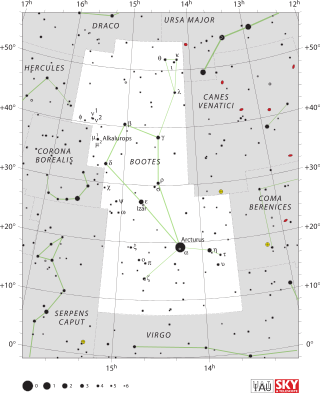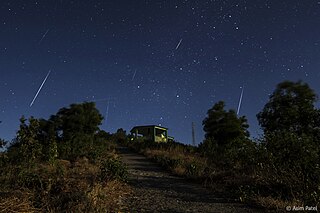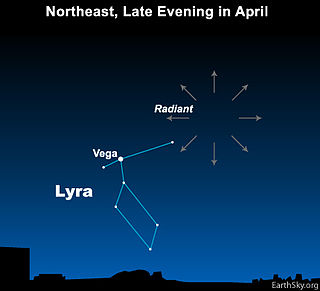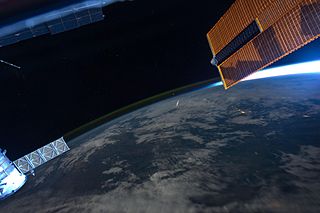
Boötes is a constellation in the northern sky, located between 0° and +60° declination, and 13 and 16 hours of right ascension on the celestial sphere. The name comes from Latin: Boōtēs, which comes from Greek: Βοώτης, translit. Boṓtēs 'herdsman' or 'plowman'.

The Geminids are a prolific meteor shower caused by the object 3200 Phaethon, which is thought to be a Palladian asteroid with a "rock comet" orbit. This would make the Geminids, together with the Quadrantids, the only major meteor showers not originating from a comet. The meteors from this shower are slow moving, can be seen in December and usually peak around December 4–16, with the date of highest intensity being the morning of December 14. The shower is thought to be intensifying every year, and recent showers have seen 120–160 meteors per hour under optimal conditions, generally around 02:00 to 03:00 local time. Geminids were first observed in 1862, much more recently than other showers such as the Perseids and Leonids.

A meteor shower is a celestial event in which a number of meteors are observed to radiate, or originate, from one point in the night sky. These meteors are caused by streams of cosmic debris called meteoroids entering Earth's atmosphere at extremely high speeds on parallel trajectories. Most meteors are smaller than a grain of sand, so almost all of them disintegrate and never hit the Earth's surface. Very intense or unusual meteor showers are known as meteor outbursts and meteor storms, which produce at least 1,000 meteors an hour, most notably from the Leonids. The Meteor Data Centre lists over 900 suspected meteor showers of which about 100 are well established. Several organizations point to viewing opportunities on the Internet. NASA maintains a daily map of active meteor showers.
The Quadrantids (QUA) are a meteor shower that peaks in early January and whose radiant lies in the constellation Boötes. The zenithal hourly rate (ZHR) of this shower can be as high as that of two other reliably rich meteor showers, the Perseids in August and the Geminids in December, yet Quadrantid meteors are not seen as often as those of the two other showers because the time frame of the peak is exceedingly narrow, sometimes lasting only hours. Moreover, the meteors are quite faint, with mean apparent magnitudes between 3.0 and 6.0.

Comet Encke, or Encke's Comet, is a periodic comet that completes an orbit of the Sun once every 3.3 years. Encke was first recorded by Pierre Méchain on 17 January 1786, but it was not recognized as a periodic comet until 1819 when its orbit was computed by Johann Franz Encke. Like Halley's Comet, it is unusual in its being named after the calculator of its orbit rather than its discoverer. Like most comets, it has a very low albedo, reflecting only 4.6% of the light its nucleus receives, although comets generate a large coma and tail that can make them much more visible during their perihelion. The diameter of the nucleus of Encke's Comet is 4.8 km.

12P/Pons–Brooks is a periodic comet with an orbital period of 71 years. It fits the classical definition of a Halley-type comet with, and is also one of the brightest known periodic comets, reaching an absolute visual magnitude ~5 in its approach to perihelion. Comet Pons-Brooks was discovered at Marseilles Observatory in July 1812 by Jean-Louis Pons, and then later recovered in 1883 by William Robert Brooks.

The April Lyrids are a meteor shower lasting from about April 15 to April 29 each year. The radiant of the meteor shower is located near the constellations Lyra and Hercules, near the bright star Vega. The peak of the shower is typically around April 22–23 each year.
The Andromedids meteor shower is associated with Biela's Comet, the showers occurring as Earth passes through old streams left by the comet's tail. The comet was observed to have broken up by 1846; further drift of the pieces by 1852 suggested the moment of breakup was in either 1842 or early 1843, when the comet was near Jupiter. The breakup led to particularly spectacular showers in subsequent cycles.
Comet C/1861 G1 (Thatcher) is a long-period comet with roughly a 422-year orbit that is expected to return around 2283. It was discovered by A. E. Thatcher. It is responsible for the April Lyrid meteor shower. Carl Wilhelm Baeker also independently found this comet. The comet passed about 0.335 AU from the Earth on 1861-May-05 and last came to perihelion on 1861-Jun-03.

Alpha Capricornids is a meteor shower that takes place as early as 7 July and continues until around 15 August. The meteor shower was discovered by Hungarian astronomer Miklos von Konkoly-Thege in 1871. This shower has infrequent but relatively bright meteors, with some fireballs. Parent body is comet 169P/NEAT.
X/1872 X1, occasionally referred to as "Pogson's Comet", was a probable cometary astronomical object seen from Madras on December 3 and 4, 1872, by astronomer N. R. Pogson.

(196256) 2003 EH1 is an asteroid, classified as near-Earth object of the Amor group. It was discovered on 6 March 2003, by astronomers of the LONEOS program at Anderson Mesa Station near Flagstaff, Arizona, in the United States. Peter Jenniskens (2003–2004) proposed that it is the parent body of the Quadrantid meteor shower. 2003 EH1 is likely an extinct comet and may even be related to the comet C/1490 Y1. 2003 EH1 came to perihelion on 12 March 2014.

Comet Swift–Tuttle is a large periodic comet with a 1995 (osculating) orbital period of 133 years that is in a 1:11 orbital resonance with Jupiter. It fits the classical definition of a Halley-type comet, which has an orbital period between 20 and 200 years. The comet was independently discovered by Lewis Swift on July 16, 1862 and by Horace Parnell Tuttle on July 19, 1862.

Comet ISON, formally known as C/2012 S1, was a sungrazing comet from the Oort cloud which was discovered on 21 September 2012 by Vitaly Nevsky and Artyom Novichonok.

209P/LINEAR is a periodic comet with an orbital period of 5.1 years. The comet has extremely low activity for its size and is probably in the process of evolving into an extinct comet.

Comet 252P/LINEAR is a periodic comet and near-Earth object discovered by the LINEAR survey on April 7, 2000. The comet is a Jupiter family comet, meaning that it passes quite close to the orbit of Jupiter.
300P/Catalina is a periodic, near-Earth comet in the Solar System with an orbital period of 4.4 years. It is the second comet ever listed on the Sentry Risk Table. At 1.4 kilometers in diameter, it is one of the largest objects ever listed on the Sentry Risk Table.

C/1963 A1 (Ikeya), also known as Comet 1963I and 1963a, is a long period comet discovered by Kaoru Ikeya on 2 January 1963. The comet last passed perihelion on 21 March 1963, when it reached an apparent magnitude of 2.8.

C/2023 P1 (Nishimura) is a long-period comet discovered by Hideo Nishimura on 12 August 2023. With an observation arc of seven months, the orbital period of the comet is estimated to be 434 years. An eccentricity of 0.996 gives the comet a semi-major axis of about 57 AU, which is comparable to the average distance of Eris at 68 AU. The comet will not leave the Solar System and will come to aphelion in 2227.















